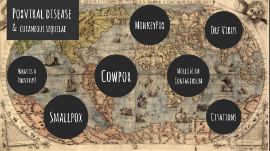Dermatology Presentation
Transcript: Presented by PERSON for COMPANY Poxviral disease & cutaneous sequelae What is a Poxvirus? What is a Poxvirus? > Oval-shaped virus with double-stranded DNA genome > Found world-wide; cause disease in humans & animals > Viral infection cause cutaneous lesions, nodules and/or disseminated rash Genus Orthopoxvirus Genus Orthopoxvirus Most notable: > Variola virus (Smallpox) > Cowpox virus > Vaccinia virus (smallpox vaccine) > MonkeyPox virus MonkeyPox Virus Electron Microscopy of Monkeypox Virions MonkeyPox Virus Vaccinia Virus Color-enhanced electron Microscopy of Vaccinia Virus Vaccinia Virus Cowpox Virus Electron Microscopy of Cowpox virions Cowpox Virus Variola Virus Color enhanced electron Microscopy of Variola Virus Variola Virus Genus Parapoxvirus Genus Parapoxvirus Most notable: > Orf Virus Orf Virus Electron Microscopy of Orf Virus Orf Virus > Molluscum Contagiosum Virus Genus Molluscipoxvirus Genus Molluscipoxvirus Molluscum contagiosum Virus Electron Microscopy of Molluscum Contagiosum Virions Molluscum contagiosum Virus Smallpox Smallpox > present for thousands of years (spread via respiratory droplets or skin-skin contact) > caused deadly epidemics in humans in which humans are the only host; 3 out of every 10 cases were fatal (Variola major) > death due to hypotension and toxemia with multi-organ failure > Last outbreak in U.S. in 1949; in world, somalia in 1977 > WHO declared complete eradication in 1980 (use of vaccinia virus vaccine) > Last strains contained at the CDC & Vektor Institute in Russia (precautionary measurement against possible bioterrorism) Signs & Symptoms Signs & Symptoms > clinical manifestations: Incubation = 7-19 days (Not contagious) no s/s. Prodromal Phase = 4-5 days; Fever (> 40 deg C), Severe headache, Malaise, N/V, Body aches. erruptive phase = 14 days (Highly contagious) errythematous macules form & turn into papules on the tongue & mouth, then spread to trunk & extremties in 24hrs, While fever subsides. vesicles form then turn into fluid-filled pustules with umbilication (always in same stage of development) up to 4-6mm in diameter. fever recurs until crusting & scabs form. Macule Papule Pustule "Pox" Vesicle Crust Scar Diagnosis & Treatment Diagnosis & Treatment > Differential diagnosis: HFMD, measles, secondary syphilis, severe chicken pox, cowpox & monkeypox. > Treatment: There is no cure. IF thought present, contact health officials immediately & Quarantine infected patient w/ respiratory & contact isolation x at least 17 days. Vaccination (Vaccinia virus vaccine) within incubation period significantly decrease risk of transmission to contacts. Roosevelt Island, NY, NY Renwick smallpox hosptial mid-1800's, opened for 19 years, 7,000 patients annually disease course disease course > course: around 14 days > common complications: Blindness from corneal ulcers, encephalitis, stillbirth/spontaneous abortion/infertility, arthritis, Osteomyelitis, Pnuemonia, severe "pockmark" scarring & possible death Prevention Prevention > Vaccinia virus vaccine > Not used in general vaccination protocol today > prevents infection in 95% of those vaccinated > pricked into 5mm area of arm & is kept covered (a papule then pustule forms that will crust over & scab in 2-3 weeks) > systemic viral rxn possible; Vaccinia immune globulin (VIG) available Clinical Subtypes Clinical Subtypes 1) Ordinary-type (discussed previously, 90% of cases). 2) modified-type (commmonaly seen in previously vaccinated individuals, duration around 10 days, no fever, less cutaneous lesions). 3) flat-type (malignant) (frequently infected children, lesions coalesce together and never form pustules, intense toxemia occurs, prior vaccination protective). 4) Hemorrhagic-type (pregnant women more susceptible, shorter incubation period, worsened prodromal s/s with higher fever, petechiae & skin/mucosal hemorrhages, death in 5-6 days due to profound toxemia & multi-organ failure, prior vaccination not protective). Source: CDC’s Dr. Robinson Source: Fenner F, Henderson DA, Arita I, Ježek Z, Ladnyi ID. Smallpox and its eradication. Geneva, Switzerland: World Health Organization; 1988 (p.33). Source: Herrlich A, Mayr A, Munz E, Rodenwaldt E. (1967). Die Poken; Erreger, Epidemiologie und klinisches Bild, 2nd ed., Stuttgart, Thieme.) Cowpox Cowpox > a zoonotic infection > transmission via skin contact with viral lesions on utter or teat cups of milking machines of an infected dairy cow. Also referred to as "Catpox," transmitted by breaks in the skin by an infected cat or small rodent > Infection seen in dairy farmers (historically, seen in milk-maids) & people who own small mammals (is not transmitted human-to-human) > Last outbreak seen in 2001 in Egypt > In 1796, edward jenner performed variolization by inoculation with the cowpox virus to confer immunity against aquiring the deadly smallpox virus Signs & Symptoms Signs & Symptoms > clinical manifestation (humans): presents as solitary or multiple erythematous ("beefy red")

















